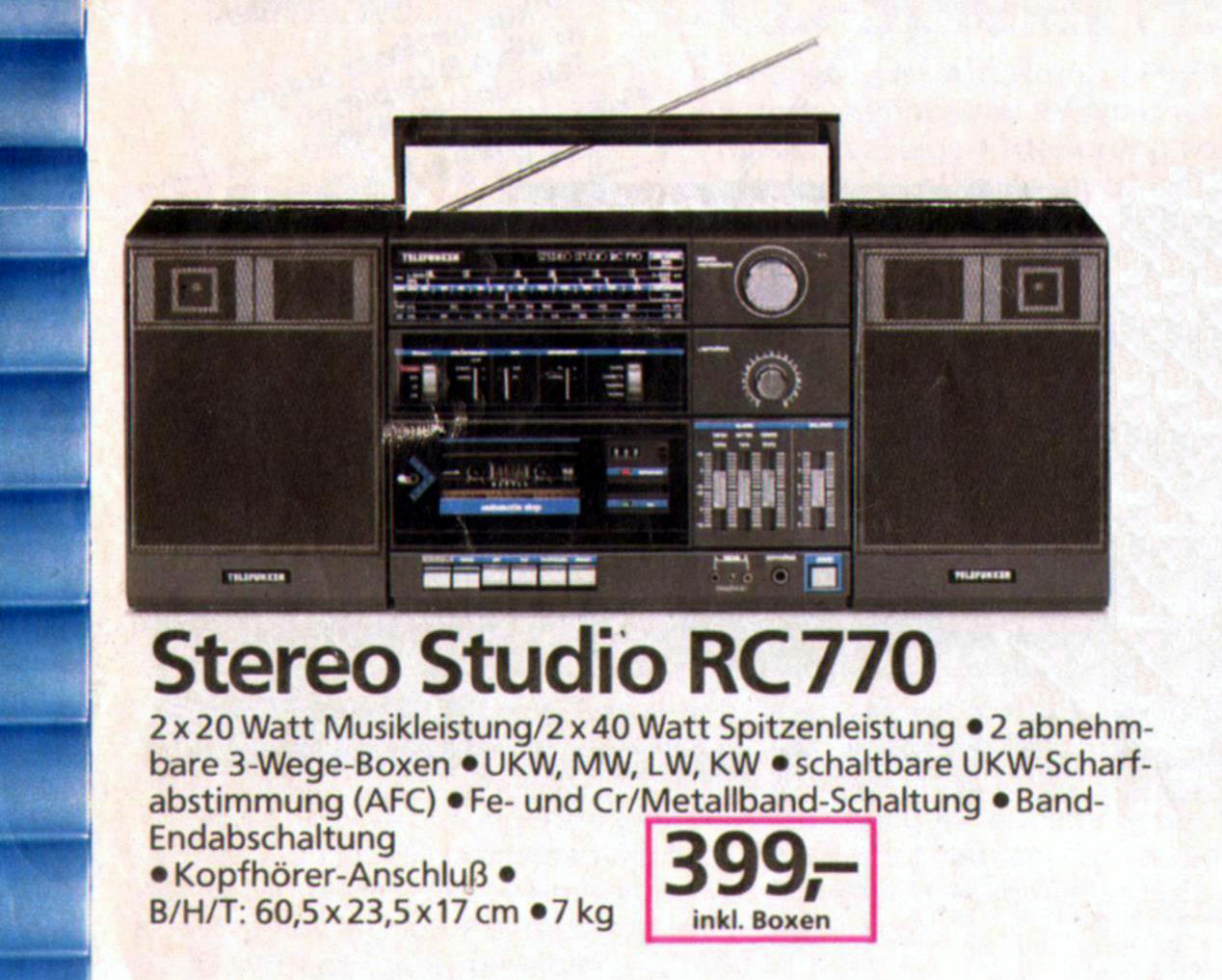Difference between revisions of "Telefunken RC 770"
| Line 1: | Line 1: | ||
__NOTOC__ | __NOTOC__ | ||
| − | == | + | == Data == |
| − | {{ | + | {{navigation}} |
| − | ''' | + | '''General''' |
| − | * | + | * Manufacturer: [[Telefunken]] |
| − | * | + | * Model: Stereo Studio RC 770 |
| − | * | + | * Type: Radio recorder |
| − | * | + | * Years of manufacture: 1986 - 1988 |
| − | * | + | * Made in: Japan |
| − | * | + | * Color: Black |
| − | * | + | * Remote control: none |
| − | * | + | * Mains and battery operated |
| − | + | Connections: 2 inputs: Phono, line-in as RCA connectors, 1 line-out also as RCA, in addition to the connection for the power cord also a 12V/15V - connection for mobile operation, 2 speaker connections also as RCA. | |
| − | + | New price approx.: see technical data | |
| − | ''' | + | '''Technical data''' |
| − | [[ | + | [[File:Telefunken RC 770-Prospekt-1987.jpg]] |
| − | == | + | == Remarks == |
| − | + | With 2x20 W music power, the unit has enough power to drive hi-fi speakers (the author increased the sound quality by several classes because of this); the included 3-way speakers, have 3 drivers, but no crossover at all (not even a capacitor in front of the tweeters). In addition, the woofer delivers almost no bass at all (as probably all comparable units do). The 3-band equalizer doesn't help much, also because its sliding potentiometers lose contact after a few years. The rotary potentiometer behind the volume control is of incomparably higher quality and still works after more than 30 years like on the first day. The mono switch for FM is useful, as it reduces the noise on FM significantly. The full-grown 6.35 mm headphone jack is also good. | |
| − | + | Other models of the same series: | |
* [[Telefunken RC 760]] | * [[Telefunken RC 760]] | ||
* [[Telefunken RC 770]] | * [[Telefunken RC 770]] | ||
| Line 29: | Line 29: | ||
* [[Telefunken Hifi Studio HP 800]] | * [[Telefunken Hifi Studio HP 800]] | ||
| − | == | + | == Pictures == |
| − | == | + | == Reports == |
| Line 38: | Line 38: | ||
| − | [[ | + | [[Category:Radio Recorder]] |
Latest revision as of 11:20, 27 October 2020
Data[edit]
General
- Manufacturer: Telefunken
- Model: Stereo Studio RC 770
- Type: Radio recorder
- Years of manufacture: 1986 - 1988
- Made in: Japan
- Color: Black
- Remote control: none
- Mains and battery operated
Connections: 2 inputs: Phono, line-in as RCA connectors, 1 line-out also as RCA, in addition to the connection for the power cord also a 12V/15V - connection for mobile operation, 2 speaker connections also as RCA. New price approx.: see technical data
Technical data
Remarks[edit]
With 2x20 W music power, the unit has enough power to drive hi-fi speakers (the author increased the sound quality by several classes because of this); the included 3-way speakers, have 3 drivers, but no crossover at all (not even a capacitor in front of the tweeters). In addition, the woofer delivers almost no bass at all (as probably all comparable units do). The 3-band equalizer doesn't help much, also because its sliding potentiometers lose contact after a few years. The rotary potentiometer behind the volume control is of incomparably higher quality and still works after more than 30 years like on the first day. The mono switch for FM is useful, as it reduces the noise on FM significantly. The full-grown 6.35 mm headphone jack is also good.
Other models of the same series:
